
Blue whales are the heaviest animals on the planet.
©Andrew Sutton/Shutterstock.com
A heavy animal is generally a big animal, but some big animals aren’t as heavy as a person would suppose. The ostrich, which can grow to nearly 7 feet tall, usually weighs between 198 and 286 pounds. A large adult male dromedary, which may be the same height, can weigh 1320 pounds. So, an animal’s weight has something to do not only with its size but with the way it’s built.
Ostriches are probably lighter than they look because their femurs or long leg bones are hollow. The leg bones of camels are not. The weight of other animals can be determined not just by the density of their bones but by how much fat or blubber they have to carry. With that in mind, here’s a preview of some of the heaviest animals in the world.:
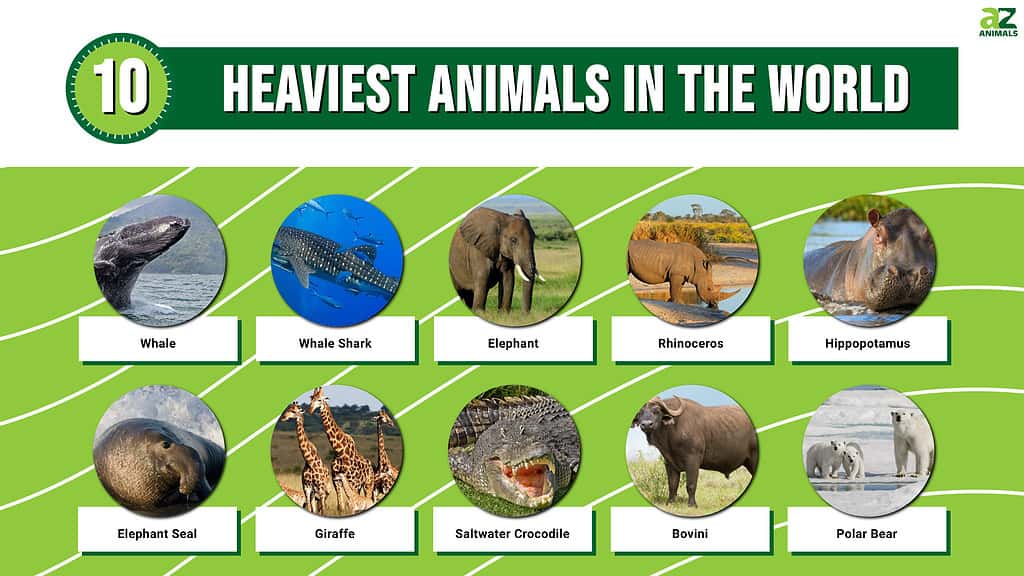
Now read on for more detail about these fascinating heavyweights. Some may not be as heavy or as light as you think!
#10. Heaviest Animals: Polar Bear
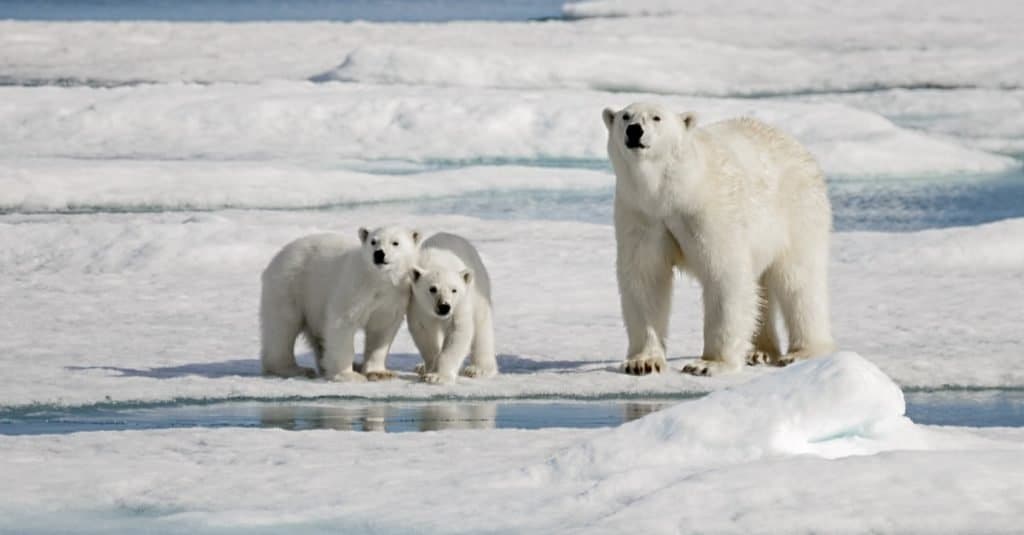
©Alexey Seafarer/Shutterstock.com
This huge and beautiful bear has evolved for life in the frozen north. It has a double coat of fur, including the guard hairs that are transparent but appear snowy white to the human eye. Beneath its fur is black skin and beneath the skin is 4 inches of fat. It has big, furry feet to spread its weight out over thin ice and to help it swim. Its teeth are big, strong, and sharp, perfect for catching and eating seals.
A big male polar bear can weigh about 1760 pounds, though the biggest bear known weighed over a ton and stood 11 feet tall. Climate change is shrinking the polar ice in the Arctic Sea and thus shrinking this bear’s habitat. Its conservation status is vulnerable.
Read here to learn more about polar bears.
#9. Heaviest Animals: Bovini
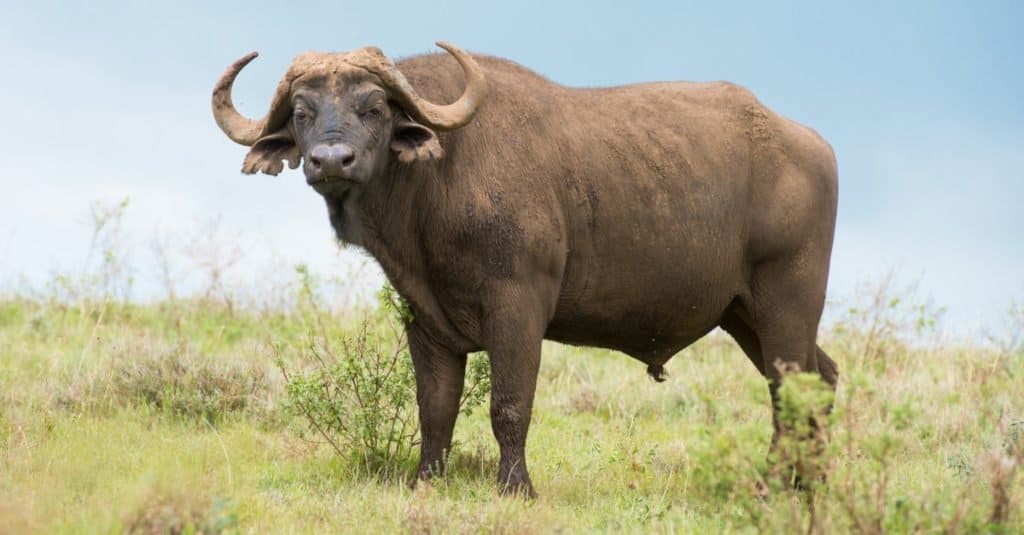
©BonnieBC/Shutterstock.com
These members of the Bovini tribe of the subfamily Bovinae are the world’s largest cattle. The gaur, found in southern and southeast Asia, is the largest of these cattle, and a large gaur bull sometimes weighs as much as 1.65 tons. The American bison can weigh 1.4 tons, while the European bison, also called the wisent is a bit lighter at 1.1 tons. The savannah-type African buffalo can weigh as much as 1.1 tons, while the forest buffalo weighs half a ton.
Read here to learn more about buffalo.
#8. Heaviest Animals: Saltwater Crocodile
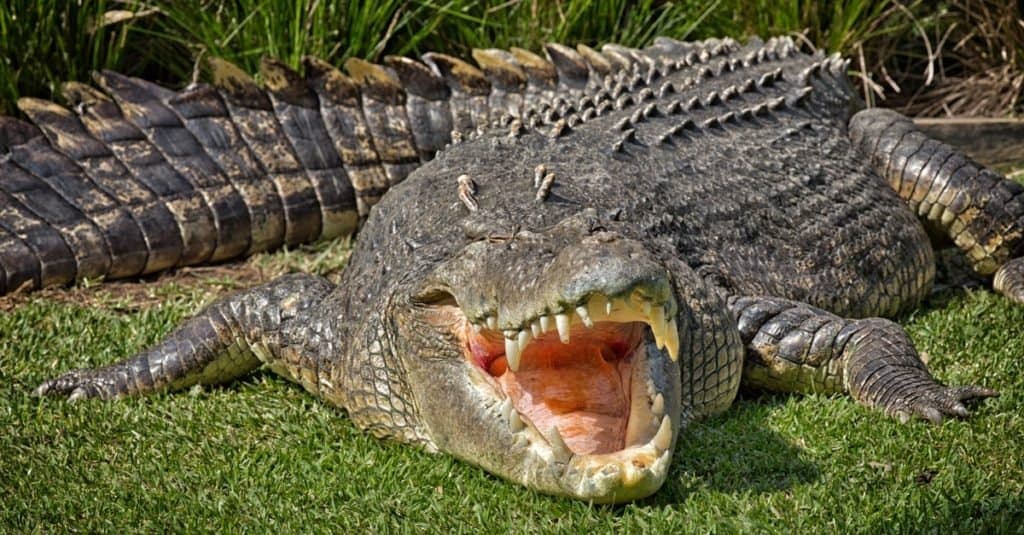
©PomInOz/Shutterstock.com
While the Nile crocodile gets the most press for being a deliberate hunter of human beings, the saltwater crocodile is bigger. It can weigh as much as 1.45 tons to the Nile crocodile’s 1.2 tons, and the 1.2-ton croc was a bit of an outlier. Like the Nile crocodile, the saltwater crocodile will catch and gulp down anything it can handle. This includes emus, monkeys, bats, and birds snatched out of the very air, goats, deer, orangutans, kangaroos, water buffalos, and human beings.
Poison toads such as cane toads do not trouble it, and one individual was believed to have eaten a porcupine. Since it lives in salt or brackish water off the coast of Southeast Asia and Oceania, the saltwater crocodile has even been known to eat sharks.
Read here to learn more about crocodiles.
#7. Heaviest Animals: Giraffe
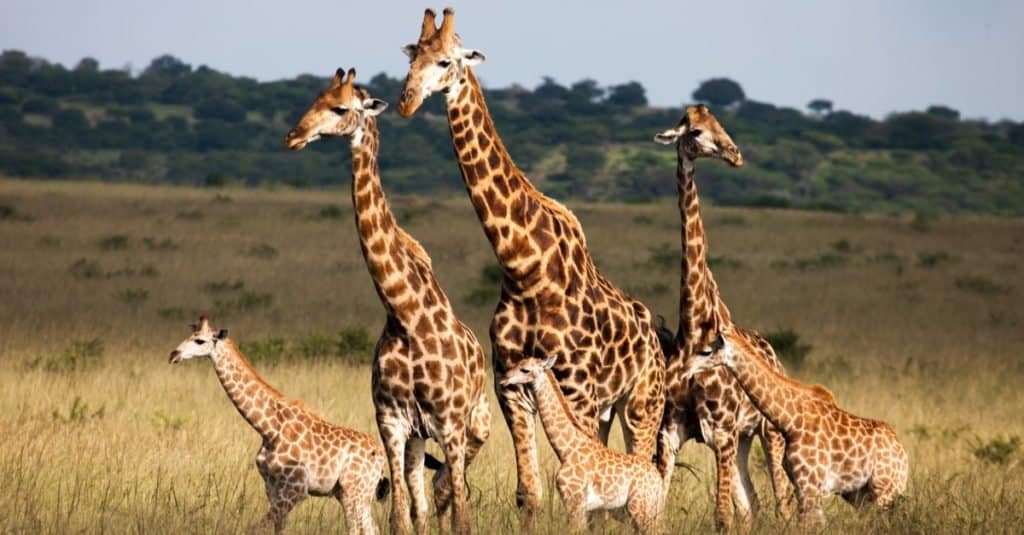
©Craig Fraser/Shutterstock.com
Though not the heaviest animal on earth, the giraffe is the tallest. It can grow to 18 feet, which makes it well adapted to life among the tall trees in the dry savannas and the acacia stands of sub-Saharan Africa. A long, prehensile tongue allows the animal to draw the thorny branches into its mouth, and its teeth snip the branches off.
The giraffe drinks in the morning and the evening then spends the rest of the day eating and chewing its cud. Drinking involves splaying its front legs, bending its neck down, and regulating its very high blood pressure so that its brain doesn’t hemorrhage. The giraffe, with its unique physiology, can weigh 2 tons.
Read here to learn more about giraffes.
#6. Heaviest Animals: Elephant Seal

©creativex/Shutterstock.com
This seal was named for the male’s nose, which inflates during the breeding season and allows its trumpeting roar to be heard far and wide. It was also named for its sheer size. A big male elephant seal can weigh 4 tons and can be 20 feet long, and a bull is about four times the size of a cow. During the mating season, which lasts two months, the bulls fight on the beach, often drawing blood. The victorious bull becomes the beach master and has access to a harem of as many as 100 cows.
After the seal pups are weaned, the adults head out to sea and stay there for much of the year, hunting for squid, skates, and small sharks. To do this, they dive as deep as 3281 feet and hold their breath for 20 minutes on average. Because they don’t eat while they are on land reproducing or molting their fur, elephant seals hunt round the clock without much rest.
Read here to learn more about elephant seals.
#5. Heaviest Animals: Hippopotamus
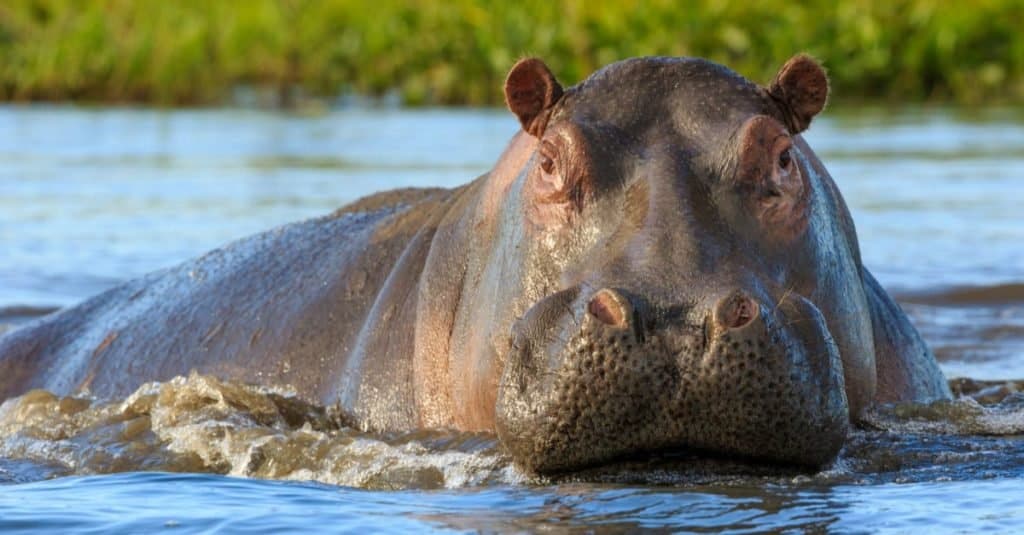
©Radek Borovka/Shutterstock.com
Its herbivorous diet, barrel-shaped body, and what seems like a laid-back semi-aquatic lifestyle hides the fact that the hippopotamus is one of the most dangerous animals in the world. At up to 4.5 tons, it has no problem using its weight to tip over boats in the water or crushes an annoying human. A set of bone-crushing teeth should not be overlooked either. Other than that, the hippopotamus is a charismatic and needful animal. It does well in zoos, and its flesh is eaten and its hide is used to make leather.
Read here to learn more about hippopotami.
#4. Heaviest Animals: Rhinoceros

©EcoPrint/Shutterstock.com
The members of the Rhinocerotidae are some of the largest animals on earth. There are five species, with two found in Africa and three found in Asia, with subspecies. The near-threatened white rhinoceros weigh 4.5 tons. It’s not white at all but brown or gray, and some people believe it got its name because someone misunderstood the Dutch or Afrikaans word for its “wide” lips.
The vulnerable Indian rhino is known for the folds over its rump, back, and shoulders, and the Rudyard Kipling “Just So Story” of how those folds came to be. It is a bit lighter than the white rhino at 4 tons. The black rhinoceros and the Javan rhino are even more svelte at 2.9 tons and 2.3 tons respectively. The black rhinoceros has a hook on its lip that allows it to grab foliage to eat and is now critically endangered, and three of its subspecies are now extinct. The Javan rhino is in even more peril, and though it used to range widely over Asia, it’s now only found in Java.
Read here to learn more about rhinos.
#3. Heaviest Animals: Elephants
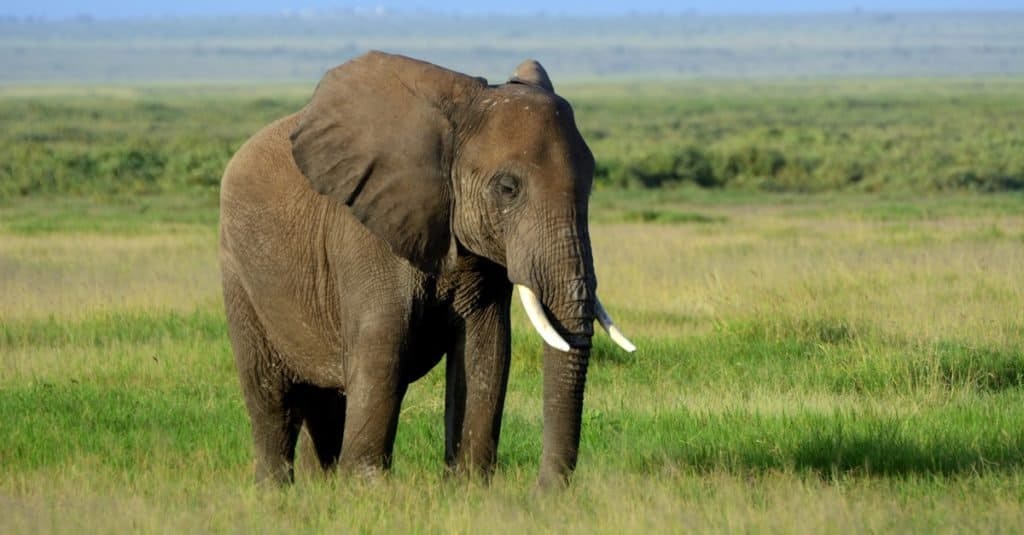
©Attila JANDI/Shutterstock.com
Elephants are the world’s largest land animals. A big bull African bush elephant can weigh 11.5 to 12.25 tons, while the smaller African forest elephant can weigh up to 6 tons. The Asian elephant weighs about 8 tons. Elephants live in herds made up of adult females and calves, while males leave the group when they reach puberty. African elephant herds are led by a matriarch, while herds of Asian elephants are a bit less hierarchical. Asian elephants can also be tamed and put to work, while African elephants can’t. Both African and Asian elephants are endangered.
Read here to learn more about elephants.
#2. Heaviest Animals: Plankton Feeding Sharks
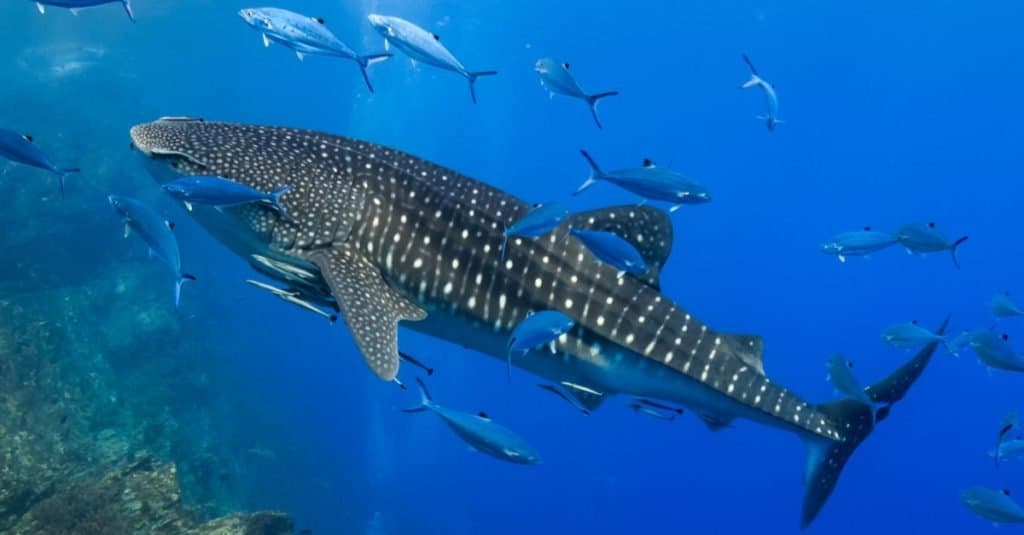
©Richard Whitcombe/Shutterstock.com
The whale shark is not a whale, but the world’s largest fish. It can weigh 20 tons. The second-largest fish, the basking shark can weigh as much as 18 tons. Both of these sharks are huge but harmless to humans and eat plankton. They do this by simply opening their mouths and swimming right into clouds of plankton, tiny fish, and invertebrates and using their gill rakers to strain them out from the water. They also simply suck them up and swallow them. The difference is that the whale shark can actively pump water through its gills, but the basking shark has to swim forward in order for water to wash through its gills.
Here’s more about whale sharks and basking sharks.
#1. Heaviest Animals: Whales

©Claude Huot/Shutterstock.com
The top 10 heaviest animals on earth are all whales. These majestic mammals were once terrestrial but returned to the sea millions of years ago. All of the ones discussed here are baleen whales save the sperm whale. Baleen whales have filters in their mouths made of keratin as opposed to teeth. They use this baleen to strain their food, often tiny animals such as krill, out of the water. At up to 219 tons, the blue whale, the largest animal on earth, is also the heaviest. It is followed by the fin whale, the bowhead, and the Northern Pacific right whale, which all come in at 120 tons. They are followed by the North Atlantic right whale and the Southern right whale, which both weigh around 110 tons. After them are the sperm whale at 57 tons, the humpback whale at 48 tons, and the gray and sei whales, which both weigh around 45 tons.
Read here to learn more about the biggest whale in the world.
Whale Lifespan
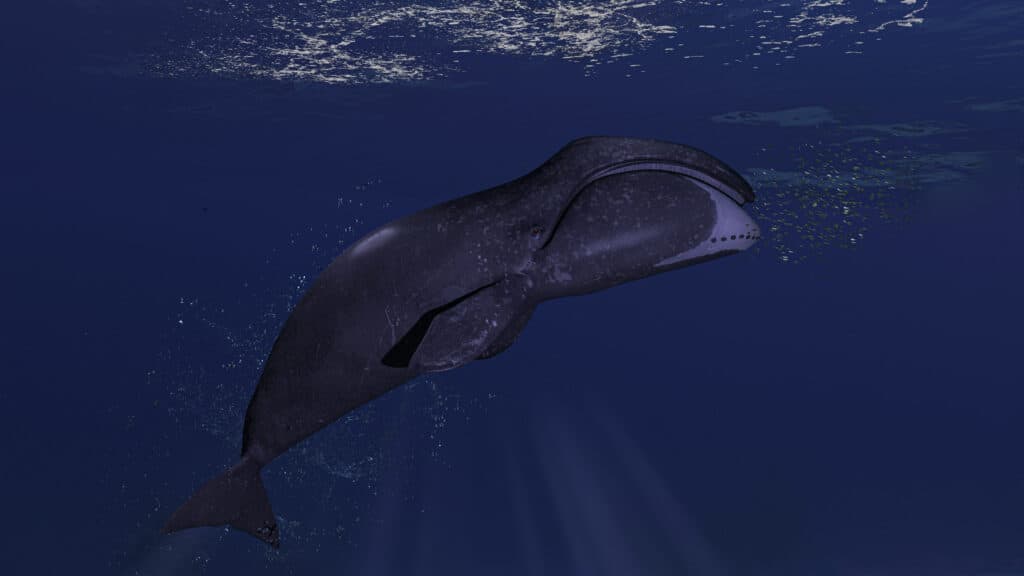
In addition to being the oldest-living species of whale, Bowheads also have the largest mouths!
©iStock.com/bbevren
In addition to being the heaviest and largest animals on Earth, whales are also the longest-living mammals. The species with the greatest potential for longevity is the Bowhead whale, with many specimens being recorded as over 200 years old. Due to the Bowhead’s arctic environment, it has developed an incredibly slow metabolism, with its heartbeat reducing to as little as 2 beats per minute during deeper dives.
Summary of the Top 10 Heaviest Animals in the World
Let’s recap the animals that earned a top spot on our list of the 10 heaviest on the planet:
| Rank | Animal | Weight |
|---|---|---|
| 1 | Whale | 48 tons to 219 tons |
| 2 | Plankton Feeding Shark | 20 tons |
| 3 | Elephant | 11.5 to 12.25 tons |
| 4 | Rhinoceros | 2.9 to 4.5 tons |
| 5 | Hippopotamus | 4.5 tons |
| 6 | Elephant Seal | 4 tons |
| 7 | Giraffe | 2 tons |
| 8 | Saltwater Crocodile | 1.45 tons |
| 9 | Bovini | 1.1 tons |
| 10 | Polar Bear | 1760 pounds (.88 tons) |
The photo featured at the top of this post is © Maggy Meyer/Shutterstock.com
Thank you for reading! Have some feedback for us? Contact the AZ Animals editorial team.






